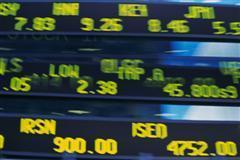| Home | About | Archives | RSS Feed |

Independent Investor: What To Expect After a Waterfall Decline
 It's been one heck of a two weeks. One would think the world was coming to an end, given the way global markets have behaved. You may not be able to make much sense of why markets sold off so quickly, but out of the carnage we may be able to predict what comes next. Here's why.
It's been one heck of a two weeks. One would think the world was coming to an end, given the way global markets have behaved. You may not be able to make much sense of why markets sold off so quickly, but out of the carnage we may be able to predict what comes next. Here's why.
Stock market free falls, such as the one we are presently experiencing, are called "waterfall declines," which are sudden drops of 20 percent or more compressed into a few short weeks or days. They are fairly rare events and most follow a roughly similar pattern consisting of three phases.
The first phase is the decline itself followed by a sharp bounce higher. We may be experiencing that bounce right now. Following the bounce (and possible re-test of the lows), the market should drift into a basing period that could last for one to three months.
During that time the market could move up and down in a sideways pattern similar to what we experienced in May through June of this year. Finally in the last phase there is a rally lasting six to 12 months that could move the markets higher by about 25 percent.
In reviewing 10 waterfall declines from 1929 thorough 2002, three months after the post-waterfall low, the stock market was higher in all 10 cases. Six months later, the market was higher in nine of the 10 cases with the average gain at 17 percent. A year later, the market was higher in nine out of 10 cases with the average gain equal to 24 percent. The financial crisis of 2008-2009 was in a league all by itself. The market, three months after the low of March 2009, was up 37 percent.
If we drill down even further, say to the next two weeks, one can expect a "relief rally" of as much as 10 percent. Then, if the pattern holds, we should "re-test" the bottom. In this case, if we have truly found a bottom for the S&P 500 Index at around 1,100, we should bounce again from there.
"So what happens if we break down through that 1,100 level?" asked a nervous client from Manhattan.
The short answer is 1,100 wasn't the bottom and we go lower, by as much as 10 percent, to S&P 1,000.
Waterfall declines are often recession-related. There have been exceptions to that rule, for example, in 1987 the market fell sharply for two days only to spring back. The Dot-Com boom and bust of 2002 was another waterfall decline that did not usher in a recession.
So what is the best way to navigate through a waterfall decline and its aftermath? It is obvious that one should ride out the turbulence; at least for the next few months. If we are truly entering into a recession, the economic data will confirm that fear or dispel it. If we are going into a double-dip, then I advise you to get defensive—bonds, dividend paying stocks, etc.
But it may turn out that the market was simply correcting, as it does periodically after a long and profitable run. Remember, the S&P 500 Index was up over 80 percent in over two years, so a 20 percent pullback doesn't look as serious from that perspective.
Bill Schmick is an independent investor with Berkshire Money Management. (See "About" for more information.) None of the information presented in any of these articles is intended to be and should not be construed as an endorsement of BMM or a solicitation to become a client of BMM. The reader should not assume that any strategies, or specific investments discussed are employed, bought, sold or held by BMM. Direct your inquiries to Bill at (toll free) or e-mail him at wschmick@fairpoint.net . Visit www.afewdollarsmore.com for more of Bill's insights.
| Tags: waterfall, bounce, stocks |
@theMarket: Quarter Ends With a Bang
 The markets presented plenty of head fakes this quarter. In January, contrary to everyone's expectations, the gains of last year kept right on coming through most of the first quarter, only to hit a brick wall in March thanks to troubles in the Middle East followed by nature's one-two punch to Japan. Despite that, the indexes finished the first quarter with the best gains in over two decades.
The markets presented plenty of head fakes this quarter. In January, contrary to everyone's expectations, the gains of last year kept right on coming through most of the first quarter, only to hit a brick wall in March thanks to troubles in the Middle East followed by nature's one-two punch to Japan. Despite that, the indexes finished the first quarter with the best gains in over two decades.
The Dow racked up 742 points (6.4 percent), the S&P 500 Index gained 68 points (5.4 percent) while the NASDAQ closed up 128 points for a 4.8 percent gain. If we annualize those gains we could be looking at a 20 percent plus gain for the year, which puts my forecast of a 20-23 percent gain in 2011 right on target.
"It was a choppy quarter though," commented one client on Friday who lives in Dalton.
I agree. Clearly this market is exacting a price (higher stress and wear and tear on the nerves) for the gains we are making. I suspect that additional volatility is waiting for us as we continue to climb a wall of worry throughout this next quarter. Some of the concerns I believe will haunt us through the spring are the price of oil brought on by geopolitical turmoil, continued problems among European financial institutions and, of course, the end of QE II, which occurs in June.
Can the economy continue to grow without the multibillion dollar monetary stimulus that the Fed has been providing for well over a year? The economy appears to be growing and unemployment declining, but is that a function of real demand or simply a response to the Fed's easy money policies? How will the stock and bond markets react to an end to this stimulus?
Smarter people than I are expecting a rapid and disastrous response by the bond markets to the sunset of QE II. They believe that interest rates will immediately spike, disrupting what little lending is already occurring and thereby throwing the economy back into recession. I find that hard to believe.
I'm going to give our central bankers, led by Ben Bernanke, the benefit of the doubt. They read the same papers we do and are well aware of the fears of the markets. Is it really plausible that the Fed will step out of the game and simply watch from the bleachers if the doomsayers are right?
There is simply too much at stake and Ben Bernanke knows it. I believe the process of pulling out of the market will be a managed one. For those who pay attention to "Fed Speak," I maintain that process is already at work. Recently a number of Board Governors who have granted interviews advised the financial community that the Fed will be taking a more neutral policy position in regards to stimulus in the future.
That's not to say there won't be concerns and with them volatility. Skittish investors will always jump the gun, many times before they actually have the facts. In today's markets, trading on rumors is just as viable as trading on the facts. So prepare for some rough sailing; but I get ahead of myself.
As a portfolio manager, it's part of my job to fret and worry about what will be, instead of enjoying what is. And a rising market is what we can expect over the next few months. Sure, we can and will have down days, but I believe they will be short and shallow. Commodity stocks will lead, so make sure you have some exposure to those sectors, and if you haven't yet, get back into the stock market — now.
Bill Schmick is an independent investor with Berkshire Money Management. (See "About" for more information.) None of the information presented in any of these articles is intended to be and should not be construed as an endorsement of BMM or a solicitation to become a client of BMM. The reader should not assume that any strategies, or specific investments discussed are employed, bought, sold or held by BMM. Direct your inquiries to Bill at (toll free) or e-mail him at wschmick@fairpoint.net. Visit www.afewdollarsmore.com for more of Bill's insights.
| Tags: stocks, Federal Reserve |
@theMarket: 707 Days
 It's official: the S&P 500 Index is now up 100 percent from its low of 666.79 back in March 2009. It was the fastest double in stock prices since 1936. And it is not over.
It's official: the S&P 500 Index is now up 100 percent from its low of 666.79 back in March 2009. It was the fastest double in stock prices since 1936. And it is not over.
I have suggested several times in past columns past that a big move in stocks would come when individual investors sold their bond holdings, gathered their courage, and returned to the stock market. That time may be upon us.
Consider that this is the fifth week in a row that inflows into domestic stock funds have increased. A total of $21.3 billion moved into equity mutual funds in January. The first week in February saw an additional $5.85 billion and last week another $9.3 billion flowed into equities.
The money is coming out of bond funds (mainly funds invested in U.S. Treasuries and Munis). As expected, the stock markets' five-month winning streak and low rates of return in the government bond markets and money markets are forcing investors back into equities. This has been my premise for well over a year.
Corporate profits are approaching record levels. The economy is gaining steam, inflation forecasts remain subdued (2-3 percent/year) and interest rates are historically low. That is what I call a "sweet spot" for making money in stocks. But the market's steady rise since the beginning of the year, with little to no corrections, has also confounded veteran market watchers. Some respected technical analysts I know have actually given up trying to predict the timing of a pullback. The truth is that a correction can happen at anytime, but so what. Buy the dip.
Consider that the U.S. market continues to rise in the face of tensions in the Middle East, soaring global commodity prices, declining stock markets in the high growth emerging markets and continued financial concerns in Europe. In the past, any one of the above circumstances has had the power to take our market down 5 percent in a blink of the eye. But thanks to "Bennie and the Fed," investors own a "put" on our market. Back in November in my column "Don't Fight the Fed" had the following explanation for why the market would continue to rise:
"The Fed is clearly telegraphing to investors that they want a higher stock market, and like unemployment and the economy, they will do what it takes to accomplish that goal. This message is behind the jump in the stock market this week. My advice to you is don’t fight the Fed. Buy stocks.”
I stand by that advice.
On another note, have you been watching the price of gold and silver? A few weeks ago I suggested that the price correction in both these precious metals was just about over. Since then both gold and especially silver have roared back to life. Silver is above $32 an ounce. It is getting closer to my target of $36-$37 an ounce, so be ready to take some profits when we reach that price level. Gold has lagged silver so far, but I believe it will ultimately narrow the lead. Nonetheless, both metals performance have been far from shabby.
Bill Schmick is an independent investor with Berkshire Money Management. (See "About" for more information.) None of the information presented in any of these articles is intended to be and should not be construed as an endorsement of BMM or a solicitation to become a client of BMM. The reader should not assume that any strategies, or specific investments discussed are employed, bought, sold or held by BMM. Direct your inquiries to Bill at 1-888-232-6072 (toll free) or e-mail him at wschmick@fairpoint.net. Visit www.afewdollarsmore.com for more of Bill's insights.
| Tags: metals, growth, stocks, bonds |
@theMarket: Corrections Are Good for the Soul
 It was long overdue. For weeks, the stock market has registered overbought conditions and still it forged ahead. Investors had driven the averages back to yearly highs and only then did the rally run out of steam. Now it's time to step aside and watch.
It was long overdue. For weeks, the stock market has registered overbought conditions and still it forged ahead. Investors had driven the averages back to yearly highs and only then did the rally run out of steam. Now it's time to step aside and watch.
"Is this the start of something big or should I just stay put?" asked a retired client from Pittsfield who has recouped much of his 2008 loses over the last year.
"Stay put," I said, "because this pullback will be short and unless you are a day trader, too volatile to do more than add to existing positions."
I'm thinking we could see the stock markets drop as much as 5 percent, which from here isn't such a big deal. Take the S&P 500 Index, for example. This week it hit an intraday high of 1,227 (almost 10 points higher than its peak in April). A 5 percent decline from that level would put the average at 1,165, a mere 30 points down from here. That's not worth getting excited about.
As a rule of thumb, I believe that 5 percent to 10 percent corrections in the stock market are the "price of doing business" or the risk one must accept in equity investing. These kinds of corrections occur 2-3 times a year on average. And it is not just equities that are falling.
Commodities are also declining. As I look at the present spot price of gold, the precious metal is off over $40 an ounce while silver is down $1.50 an ounce and oil has plummeted over $3 a barrel — in just one day. Commodities tend to have extremely sharp, if short, corrections that tend to wilt most amateur investors' resolve to stay invested. It appears that once again those who have chased energy, precious metals and agricultural commodities are suffering big reversals this week. Rather than buy this weakness, they tend to sell in panic.
For those with bullish convictions, this pullback is a buying opportunity, not only in commodities but stocks in general. This coming week should provide further opportunities to establish new positions. Some of the areas I favor for additional investment are emerging markets, real estate such as REITs, commodities, commodity companies and selected technology.
As for the culprits that triggered the pullback, most of the negative events have something to do with governments. The on-again-off-again saga of the European debt crisis has reignited fresh worries over Ireland's struggle to rescue its financial system. It has led investors to re-examine Europe's financial situation in general.
At the same time, China is rumored to be hiking interest rates in an attempt to slow their economy. That would spell bad news for everyone since China has become the new locomotive of global growth. Over in Korea, where the G20 adjourned without agreeing on how to curb the growing currency war, left investors worried and disappointed over the fate of the U.S. dollar.
All of the above are serious issues but they have been with us throughout the year. China has raised rates before and emerging market growth is still quite healthy. The problems of Europe's smaller economies will continue to plague the Euro and the European Community for the next few years, but has not stopped their stock markets from enjoying substantial gains over the last six months.
The financial world is fully aware of every nuance of the currency debate. The dollar has declined since late August, sending stocks and commodities ever upward. None of this is new. Consider this pullback a healthy correction and that's all you need to know.
All these reasons for the sell-off will still be with us a month from now when the averages have regained their upward ascent, so don't put too much stock in today's headlines. They are fleeting at best. Focus instead on the opportunities this sell-off will present.
Bill Schmick is an independent investor with Berkshire Money Management. (See "About" for more information.) None of the information presented in any of these articles is intended to be and should not be construed as an endorsement of BMM or a solicitation to become a client of BMM. The reader should not assume that any strategies, or specific investments discussed are employed, bought, sold or held by BMM. Direct your inquiries to Bill at 1-888-232-6072 (toll free) or e-mail him at wschmick@fairpoint.net. Visit www.afewdollarsmore.com for more of Bill's insights.
| Tags: corrections, stocks, metals, China, commodities |
The Independent Investor: Don't Fight the Fed
 Now that QE II is in the bag, expect QE III, QE IV and maybe even a QE V, if that's what it takes to restore economic growth and reduce the unemployment rate to under 7 percent in this country. After the mid-term election results, I believe the Federal Reserve is all that stands between us and a stagnant, deflationary economy. I would not bet against them in this endeavor.
Now that QE II is in the bag, expect QE III, QE IV and maybe even a QE V, if that's what it takes to restore economic growth and reduce the unemployment rate to under 7 percent in this country. After the mid-term election results, I believe the Federal Reserve is all that stands between us and a stagnant, deflationary economy. I would not bet against them in this endeavor.
Most of Wall Street is expecting fiscal gridlock in Washington now that the GOP has re-taken the House but is still the minority in the Senate. That will mean little if any new initiatives to either grow the economy or drive down unemployment have much chance of passing. One exception may be a compromise on the Bush tax cuts.
If both sides can muster enough cooperation to cut a deal in extending the tax cuts before the end of the year (when they are set to expire) then we may escape an economic knockout punch of monumental proportions. Outside of that, there is not much that we should expect from the government over the next two years.
That means that only the Federal Reserve Bank, led by Chairman Ben Bernanke and his band of 12 governors, are left to wage the good fight against the forces arrayed against our economy. Their mandate, to promote low, stable inflation and a high level of employment, gives them enough latitude to do just about whatever they feel necessary to jump start the economy. It appears they are doing just that.
QE II not only says the Fed is serious about that mission but signals an intention, in my opinion, that if this one doesn't work, another one will already be in the pipeline, followed by another, and another. That is entirely believable since the Fed can and will continue to print money (U.S. dollars) until the cows come home in an effort to grow the economy, which is the only way they can reduce unemployment.
In an Op-Ed piece in the Washington Post on Thursday, Bernanke defended the Fed's second quantitative easing and stated several things that you should read as Gospel:
"... the heavy costs of unemployment include intense strains on family finances, more foreclosures and loss of job skills."
"... inflation is running somewhat below 2 percent."
"... higher stock prices will boost consumer wealth and help increase confidence, which can also spur spending.”
"... Increased spending will lead to higher incomes and profits that, in a virtuous circle, will further support economic expansion."
Bernanke said next to nothing about the dollar since he did not want to give the impression that the U.S. was deliberately driving the dollar lower (although that is exactly what QE II will do). If you don't believe that just take a peek at the decline in the greenback lately. As I have said in the past, the dollar will continue to weaken as the Fed prints more and more money. A lower dollar will boost commodity prices such as gold, silver, energy, materials and agricultural food items. So ignore the naysayers who say commodity prices have run their course.
As far as the Fed is concerned, pumping more money into the economy is OK, at least for now, since the inflation rate is "a bit lower than the rate most Fed policymakers see as being consistent with healthy economic growth in the long run."
But the most important message investors should take away from his Op-Ed is his extraordinary comment concerning higher stock prices. Evidently the Fed believes higher stock prices should be part and parcel of its attempt to grow the economy. The reasoning makes sense when you consider that consumers are the linchpin of this economy. Given that our two main pillars of wealth, our tax-differed retirement savings and our homes, have taken a huge hit since 2008, any improvement in one or both of these assets should help improve our confidence and therefore our spending. That message is clear in the bullet points above.
The Fed is clearly telegraphing to investors that they want a higher stock market, and like unemployment and the economy, they will do what it takes to accomplish that goal. This message is behind the jump in the stock market this week. My advice to you is don't fight the Fed. Buy stocks.
Bill Schmick is an independent investor with Berkshire Money Management. (See "About" for more information.) None of the information presented in any of these articles is intended to be and should not be construed as an endorsement of BMM or a solicitation to become a client of BMM. The reader should not assume that any strategies, or specific investments discussed are employed, bought, sold or held by BMM. Direct your inquiries to Bill at 1-888-232-6072 (toll free) or e-mail him at wschmick@fairpoint.net. Visit www.afewdollarsmore.com for more of Bill's insights.
| Tags: Federal Reserve, Bernanke, economy, stocks |
|

